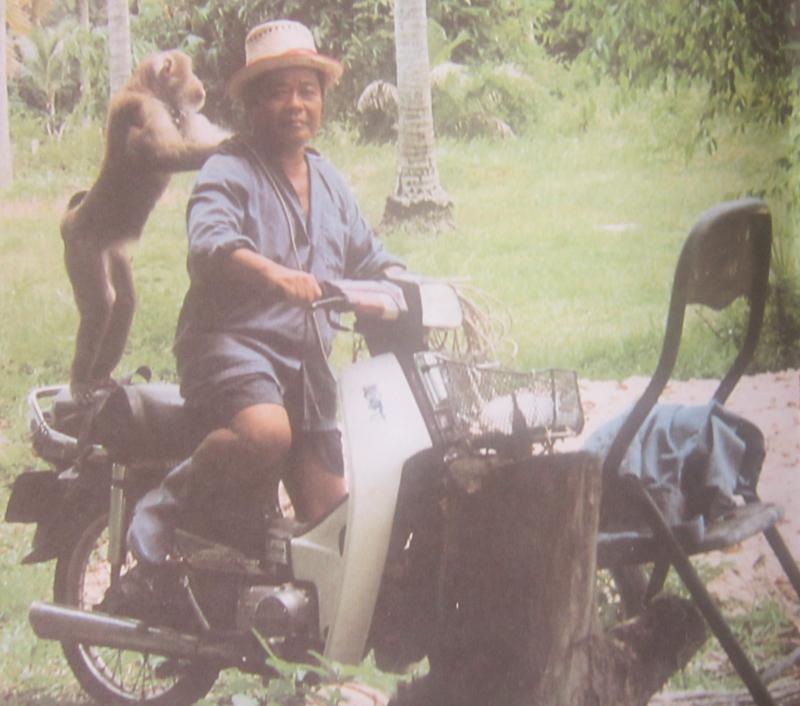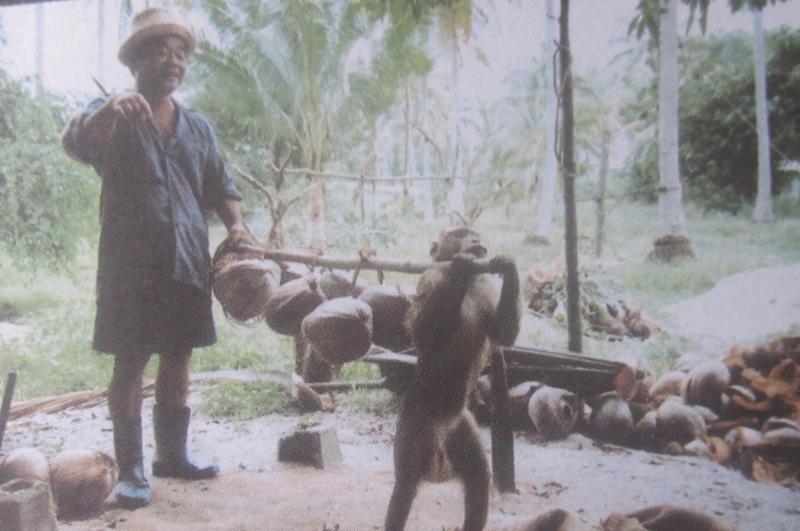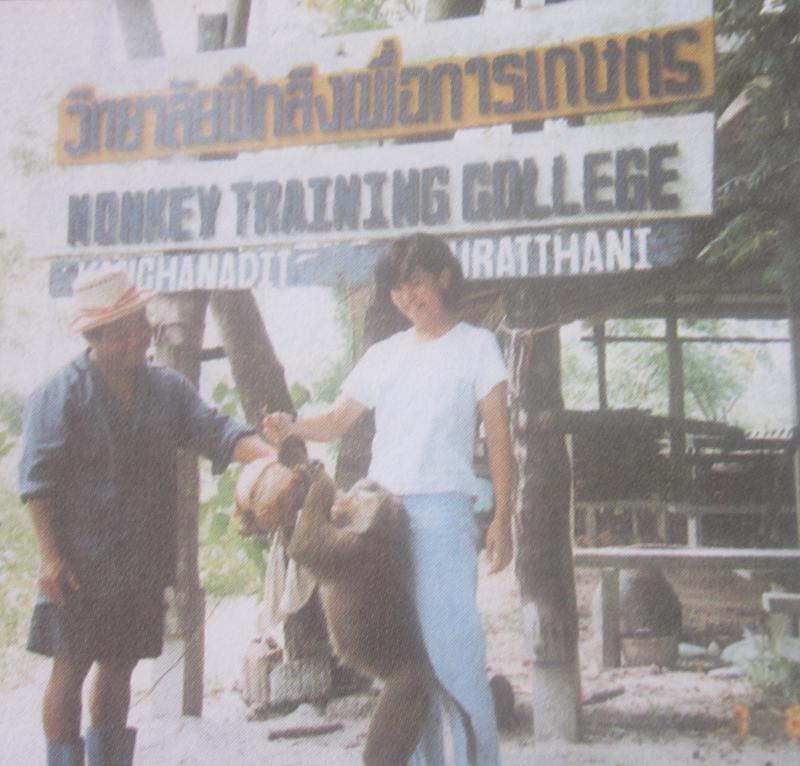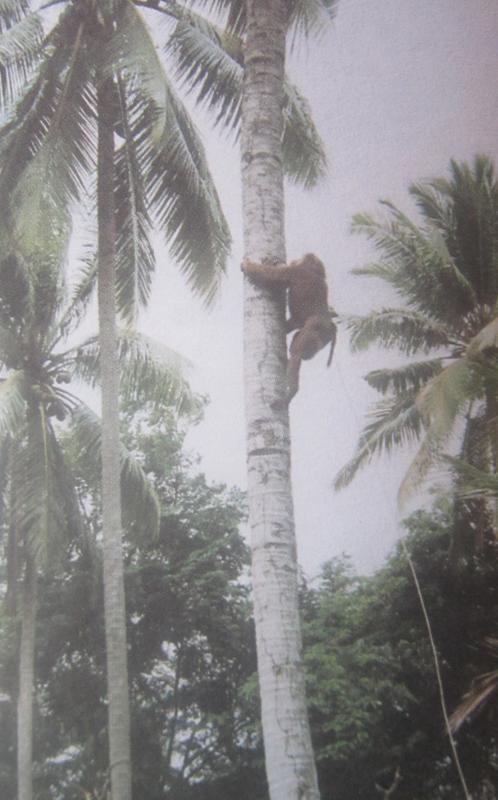Monkeys Go To School

By Gee-Gee Torres
The coconut and copra is a mainstay in Thailand. They often use monkeys to help out but these are untrained and sometimes beaten mercilessly. When our editorial assistant, Gee-Gee Torres, went to Thailand recently to visit the various Filipino missionary communities there, they brought her on a side-trip to the famous school for monkeys set-up by a humane man who feels monkeys deserve to be treated better. We hope you enjoy reading the story below.
Have you ever heard of a monkey going to college? This sounds crazy, but it’s true. When I visited the Filipino missionaries in Thailand last year, I slipped over to Suratthani to see the famous school for my self.

Monkey College
A man wearing a straw hat welcomed us smiling face. He’s the owner of the Monkey’s Training College, Mr. Saekhow. His school wouldn’t win any award for architectural design. It was not a typical college buildings but instead it had coconut trees all around the place and a makeshift classroom. But I think the school deserves an award for the best Monkey Training School. In fact tourist, including experts, visit this school when they are in Thailand.
Mr. Saekhow
Mr. Saekhow started training monkeys as helpers when he was 17. “Before there was no school for monkeys. Monkeys were trained by the owner in whatever ways. There are some who physically beat their monkeys,” he said. “I pitied the monkeys and so I decided to build a school for the monkeys. A school where they will be treated with compassion.”
There are also a few others who train monkeys domestically but Mr. Saekhow is the only trainer who established a school were monkeys live with him for several months before they are returned to their owners to work on the plantations. It took Saekhow many years of trial and error until he finally discovered the right training module for the monkeys. Now at 57 he still continues to train monkeys. What’s his secret? Let’s find out.
In the first day of school, Mr. Saekhow acquaints each new student to his new surroundings. Mr. Saekhow observes the monkeys if he is trainable or not. If a monkey is trainable, Mr. Saekhow introduces him to the training areas where he will learn the skills needed to pick coconuts. Only brown ripped coconuts (the kind which each monkey will eventually pick) are hung all around the school.
Nursery School
At this stage, each student is given his seat within visual range of his classmate. They are arranged according to the number of months they have attended school and according to the skills they have already mastered. This allows them to see what they will learn in the future.

Formal Training
Formal Training begins when Mr. Saekhow teaches a monkey how to spin off a coconut from the coconut tree. He uses a device made of wooden box with a brown coconut attached to the middle of the box through a rod pole. He sits at a safe distance away from the monkey, places the wooden box between his knees and begins spinning the coconut on its axle for an hour everyday while the monkey watches him do this.
Building Trust
1. Then Mr. Saekhow moves closer to the monkey.
2. If the monkey already feels comfortable with him sitting close by, Mr. Saekhow pats the monkey while he continues to spin the coconut.
3. Then slowly he holds the monkey's front paws and guides him to the coconut.
4. Mr. Saekhow then attaches the monkey’s collar by a rope to his own belt and calls out “Pick!” while the monkey spins the coconut.
After about 20 days, a coconut is attached to a bamboo pole. The monkey, still attached to Mr. Saekhow’s belt, learns to spin the coconut off the pole. Once the monkey gets used to this, Mr. Saekhow removes the belt and uses only a guide rope.
For the next two months, the monkeys will practice this step as Mr. Saekhow gradually increases the level of difficulty to approximate actual conditions when picking coconuts from the tree. The monkey is instructed to spin the coconut until it falls to the ground. Once mastered, the monkey is said to have graduated Nursery School.

Elementary School
Now the student moves on the elementary school. He is taken outside the classroom. He is brought to a bamboo pole to which coconuts have been attached. The monkey then repeats the spinning technique which he learned in nursery school to make the coconut fall off the pole. Gradually the attached coconuts are moved higher up the pole. Once the monkey can comfortably work high up the pole, Mr. Saekhow trains the monkey to jump from one bamboo pole to another without climbing down. At this stage the monkey is also taught how to fetch fallen coconuts which may have rolled too far for the owner to gather, and even fetching coconuts out of a pond or stream. Once mastered the monkey is about to graduate elementary school.
The big day for the monkey is when Mr. Saekhow finally brings him to the coconut plantation outside their classroom. Mr. Saekhow tells him to pick brown coconuts from the coconut trees. If the monkey picks all brown coconuts, he passes the final exam and can now go home and return to the plantation to work for its owner. However if he picks a green coconut, he cannot graduate yet.
Junior High School
The monkeys can continue to junior high school which may take as long as six months, if the owner wishes him to. During this phase, they will learn other skills such as how to load and unload coconuts into a vehicle, how to hand a worker coconuts to be peeled from their outer husks, how to load peeled coconuts into a bag two at a time, how to put the things of his owner such as bolo, rope, hat, drinking glasses o to the vehicle and even learn good manners (i.e. the monkey only eats when the owner invites him to do so). Such skills save the owner considerable time and labor and helps the owner avoid the chronic backaches which so often plague workers in this industry.
Mr. Saekhow is a very patient and kind man who never raises his voice or physically punishes the monkeys, even if he is bitten. He makes sure that the owners are trained how to handle the monkeys before he sends them home. I felt he was a man of compassion and I felt I had learned something of how we ought to treat animals.
